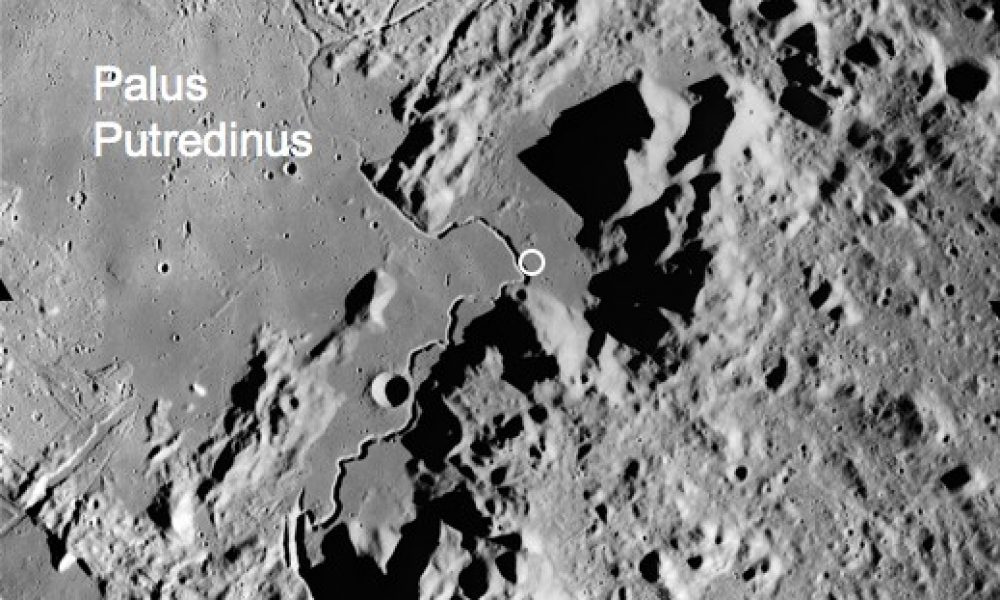Lookout Observatory: making lemonade
Dear Friend of Lookout Observatory,
We have had lots of cloudy, rainy weather in northern California lately. This is good for ending the terrible drought we have had here, but it is not good for taking astronomical pictures. We finally got a few clear nights a week ago, but by then the Moon was past first quarter, heading on toward full, and a bright Moon makes it difficult to photograph faint deep sky objects like nebulae and distant galaxies. Since these are my favorite objects, I don’t even try when the bright Moon is ruining the prospects. But in an effort to turn a lemon into lemonade, I decided to try photographing the Moon itself up close, something I haven’t tried for many years.
I used my 8-inch diameter telescope, first at it’s normal f/8 focus, then with a Barlow lens which doubles it’s focal length to f/16. Both these focal lengths are so long (so high a power) that the whole Moon won’t fit into the camera image, so both of my images are of only a portion of the Moon. The phase of the Moon was about 9.6 days past the last new Moon.
The first picture is of the north central section of the Moon. It covers about 1/3 the diameter of the Moon from north to south and about 1/5 of the diameter from east to west. It seemed appropriate to be thinking about the Moon because recently there has been talk about sending people to the moon again, and we are nearing the 50th anniversary of the first moon landing. The first humans to set foot on the Moon were Neil Armstrong and Buzz Aldrin on the Apollo 11 Mission. They landed on July 20, 1969 and spent about 21 ½ hours on the surface. Unfortunately, I did not photograph that part of the Moon where they landed. However, my first picture does capture the area where David Scott and James Irwin of the Apollo 15 Mission landed. They were on the moon from July 30 to August 2, 1971. This was the 4th lunar landing and the first with the lunar roving vehicle and a 3-day stay. They landed where the blue dot is inside the blue square.
If you enlarge my image greatly until it gets blurry, you may be able to see a faint white, wiggly line running down and to the left from the blue dot. For a clearer view, look at the next picture, courtesy of NASA and the internet. This picture is of the same area as my blue square, but taken from the Lunar Reconnaissance Orbiter only 80 miles above the Moon. The white circle shows the landing location. That my image can show as much detail as it does, even though my camera is 3,000 times farther away from the Moon than NASA’s camera is a testament to the wonders of today’s imaging technology.
The Apollo 15 Mission landed near that wiggly line deliberately so they could explore it. It is called Hadley Rille, and it is about 1 mile wide and 80 miles long. Though it looks like a river meandering through a valley, lunar rilles like this one are thought to be channels formed by erosion over a collapsed lava tube. The third picture (also courtesy of NASA and the internet) is one taken by astronaut Irwin showing what Hadley Rille looked like from on the ground.
And finally returning to Earth, or rather the Moon as seen from the Earth, we come to my last picture. I took this with the longer focal length of 3250mm, so it is twice the magnification of my first picture, and the camera was turned slightly compared to the first image. It is of Plato, the large dark crater near the left side of the first image. In this last image, the mountains to the right of Plato are the lunar Alps, and to their right is the Alpine Valley. It is about 100 miles long and 6 miles wide at its widest. If you enlarge the image, you can just make out a 1/3-mile-wide rille meandering down the center of the valley floor. Plato itself, 60 miles across, has small craterlets scattered across its otherwise smooth floor. My image barely reveals the 5 largest, the smallest of which is 1 mile across. In high school I got my first large telescope, 8 inches in diameter. I remembering struggling to see a craterlet on Plato’s floor during a brief moment of clear seeing through our turbulent atmosphere. Now, 60 years later, we can snatch those brief moments from literally thousands of images, fix them in a single image, and study it at leisure – while relaxing with a glass of lemonade!
May peace be with you,
Carter








